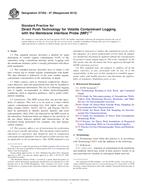Potrebujeme váš súhlas na využitie jednotlivých dát, aby sa vám okrem iného mohli ukazovať informácie týkajúce sa vašich záujmov. Súhlas udelíte kliknutím na tlačidlo „OK“.
ASTM D7352-07(2012)
Standard Practice for Direct Push Technology for Volatile Contaminant Logging with the Membrane Interface Probe (MIP)
Automaticky preložený názov:
Štandardné praktiky pre Direct Push technológie pre prchavé kontaminanty protokolovanie s membránou rozhranie Probe (MIP)
NORMA vydaná dňa 15.10.2012
Informácie o norme:
Označenie normy: ASTM D7352-07(2012)
Poznámka: NEPLATNÁ
Dátum vydania normy: 15.10.2012
Kód tovaru: NS-38258
Počet strán: 11
Približná hmotnosť: 33 g (0.07 libier)
Krajina: Americká technická norma
Kategória: Technické normy ASTM
Kategórie - podobné normy:
Anotácia textu normy ASTM D7352-07(2012) :
Keywords:
CPT, direct push, electrical conductivity, membrane interface probe, MIP, soil investigations, VOC, volatile organic contaminants, ICS Number Code 13.080.05 (Examination of soil in general)
Doplňujúce informácie
| Significance and Use | ||||||||||||||
|
5.1 The MIP system provides a timely and cost effective way 5.2 Correlation of a series of MIP logs across a site can provide 2-D and 3-D definition of the contaminant plume. When lithologic logs are obtained (EC, CPT, etc.) with the MIP data, contaminant migration pathways may be defined. 5.3 The MIP logs provide a detailed record of contaminant distribution in the saturated and unsaturated formations. A proportion of the chlorinated and non-chlorinated volatile organic contaminants in the sorbed, aqueous, or gaseous phases partition through the membrane for detection up hole. 5.4 The data obtained from application of this practice may be used to guide soil (Guide D6282) and groundwater sampling (Guide D6001) or placement of long-term monitoring wells (Guide D6724). 5.5 MIP data can be used to optimize site remediation by knowing the depth distribution of volatile organic contaminants. For example, materials injected for remediation are placed at correct depths in the formation. 5.6 This practice also may be used as a means of evaluating remediation performance. MIP can provide a cost-effective way to monitor the progress of remediation. When properly performed at suitable sites, logging locations can be compared from the initial investigation to the monitoring of the contaminant under remediation conditions. 1.1 This standard practice describes
a method for rapid delineation of volatile organic contaminants
(VOC) in the subsurface using a membrane interface probe. Logging
with the membrane interface probe is usually performed with direct
push equipment.
1.2 This standard practice describes how to obtain a real time vertical log of volatile organic contaminants with depth. The data obtained is indicative of the total volatile organic contaminant concentration in the subsurface at depth. 1.3 Other sensors, such as electrical conductivity, fluorescence detectors, and cone penetration tools may be included to provide additional information. The use of a lithologic logging tool is highly recommended to define hydrostratigraphic conditions, such as migration pathways, and to guide confirmation sampling. 1.4 Limitations—The MIP system does not provide specificity of analytes. This tool is to be used as a total volatile organic contaminant-screening tool. Soil and/or water sampling (Guides D6001, D6282, D6724, and Practice D6725) must be performed to identify specific analytes and exact concentrations. Only VOCs are detected by the MIP system in the subsurface. Detection limits are subject to the selectivity of the gas phase detector applied and characteristics of the formation being penetrated (for example, clay and organic carbon content). 1.5 This practice offers a set of instructions for performing one or more specific operations. This document cannot replace education or experience and should be used in conjunction with professional judgment. Not all aspects of this practice may be applicable in all circumstances. This ASTM standard is not intended to represent or replace the standard of care by which the adequacy of a given professional service must be judged, nor should this document be applied without the consideration of a project’s many unique aspects. The word “standard” in the title means that the document has been approved through the ASTM consensus process. 1.6 This standard does not purport to address all of the safety concerns, if any, associated with its use. It is the responsibility of the user of this standard to establish appropriate safety and health practices and determine the applicability of regulatory limitations prior to use. |
||||||||||||||
| 2. Referenced Documents | ||||||||||||||
|
Odporúčame:
Aktualizácia technických noriem
Chcete mať istotu, že používate len platné technické normy?
Ponúkame Vám riešenie, ktoré Vám zaistí mesačný prehľad o aktuálnosti noriem, ktoré používate.
Chcete vedieť viac informácií ? Pozrite sa na túto stránku.




 Cookies
Cookies
